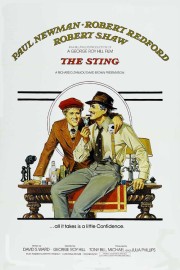The Sting
It’s kind of shocking that I’m only now watching “The Sting,” considering it was 25 years ago that I watched “Butch Cassidy and the Sundance Kid.” I came to that, however, because of writer William Goldman, who had just written the “Maverick” film, and not the director (George Roy Hill) and stars (Robert Redford and Paul Newman) who would later reunite for this Best Picture winner. Still, good things come to those who wait, and “The Sting” is a very good thing, indeed.
I can only image the amount of fun audiences had when they got this reuniting between Redford and Newman in 1973. “Butch Cassidy” is one of the most wonderfully entertaining movies in Hollywood history, and a huge part of that is the effortless chemistry between the two stars as famous bank robbers in the old west. In “The Sting,” they find their way into 1930s Chicago as a couple of con men, but while the chemistry of Butch and Sundance remains intact, the characters they play- Johnny Hooker (Redford) and Henry Gondorff (Newman)- are very different, as is their dynamic. Hooker is a low-rent con artist whom steals from the wrong guy, and Gondorff is a mentor he pulls out of retirement when that guy, the New York banker/criminal Doyle Lonnegan (Robert Shaw), is coming into town to take care of the people responsible. The con is on almost from the get go.
If you’ve watched any heist movie or con movie at any point in the past 45 years, it’s a good bet that you’ll be able to figure out what Hill and his screenwriter, David S. Ward, are up to here, because they’ve all studied Ward’s fantastic script and structure to the letter. What makes “The Sting” stand out, apart from the wonderful lead performances by Redford and Newman, is the effortless storytelling Hill and Ward deliver here, even as the film tells its story in chunks. “The Sting” basically walks us through the con Hooker and Gondorff are pulling off in sections, starting with the initial events that lead to the con, and going through each beat of the story. While it’s broken up into sections, it follows a straightforward narrative built on the complexity of the story, the personalities of the characters, and the way each section builds to a conclusion that adds something more to the larger narrative. “The Sting” was certainly not the first heist film Hollywood ever produced, but it is possibly the very best we’ve ever seen, and everything else after it is just working off of what it did.
The script is the main reason for “The Sting’s” success, but it’s not the only thing that makes it as fun, and as good, as it is. Hill puts us into 1930s Chicago effortlessly through the film’s production design and Edith Head’s costumes, with adaptations of Scott Joplin piano rags by Marvin Hamlisch all over the soundtrack. This cast, though, is why “The Sting” is one of the great entertainment films in history. Redford and Newman are the main attraction, and they are as good here as they were in “Butch Cassidy,” but the supporting cast is what elevates it to great, whether you’re talking about Robert Shaw as Lonnegan or Charles Durning as a Chicago cop on Hooker’s tail or Ray Walston as one of Gondorff’s accomplices and many other actors who have brief moments, and keep this light and fun. Now that I’ve seen “The Sting” once, I cannot wait to watch it again.










